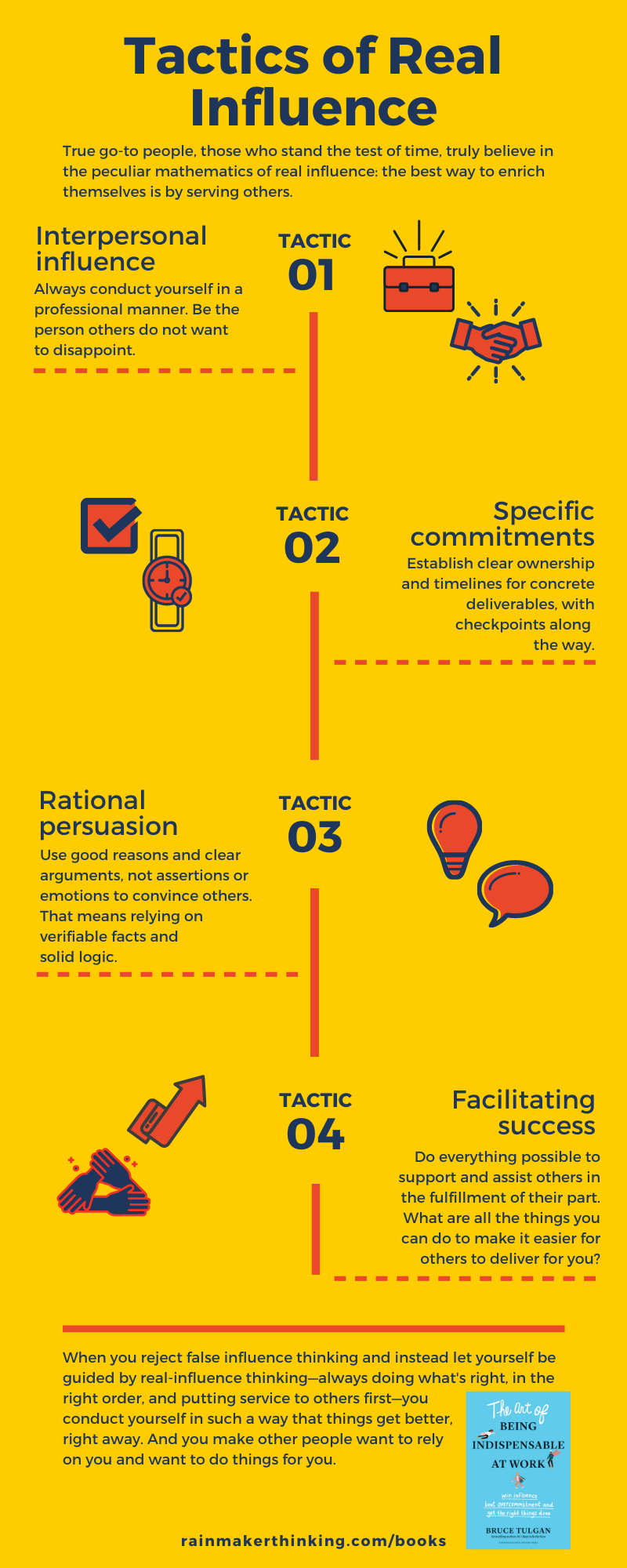When You Don't Have Authority, Use Influence

When work is highly collaborative, there arises an authority conundrum. When there's a problem or delay, and you're left to work things out at your own level, nobody has the power of rank to resolve things swiftly and efficiently. In those situations, my advice has always been: when you don't have authority, use influence. But there's a problem with that.
The problem with influence is there are so many forms of FALSE influence:
Outright bribe
Quid pro quo
Freeze-out
Charm and flattery
Going over your head
Badgering
Finger-pointingMy latest for @TrainingMagUS: https://t.co/7VglITjEY2
— Bruce Tulgan (@BruceTulgan) October 13, 2020
The problem is that too many people believe influence is about playing workplace politics, building personal rapport, or establishing a quid pro quo with others. That's what I call false influence. Real influence is a generous, other-centered focus based on adding value in every single interaction.
If you understand the mathematics of real influence--and believe in it--you can make yourself incredibly rich in a very potent source of power by dedicating yourself to serving others, moment by moment, in every interaction.
There are four tactics of real influence.
[BE A BETTER COLLABORATOR BUY THE ART OF BEING INDISPENSABLE AT WORK]
1. Interpersonal influence
Interpersonal influence is the most common form of real influence, but it is easy to approach this tactic incorrectly. The mistake most people make is thinking interpersonal influence is all about building personal rapport, being charming, or buttering up their colleagues. The better way to develop interpersonal influence in the workplace is to make it all about the relationships you have as a result of the work you share.
True go-to people I have seen leverage interpersonal influence in the workplace--such as Sue Unvarsky, Shaun McConkey, and Dr. Lisa Wolf--have all built reputations for being the type of person other people do not want to disappoint. They conduct themselves in a professional and businesslike manner. They can be relied on to deliver for others. They make a point of thanking others for their contributions. And they hold others to a high standard.
You may be surprised how much of an impact that high standard can have on someone else. But give it a try. If they don't set a high bar for themselves--or even if they do--set it higher. Many people will be motivated to live up to your perception of them.
[RELATED: THE THREE PART FOLLOW-UP]
2. Specific commitments
Often, collaboration breaks down as the result of insufficiently clear alignment and communication. That's especially true now that many people are working from home.
The solution is simple (though not necessarily easy): practicing high-structure, high-substance communication. High-structure means regularly scheduled conversations, conducted according to a specific agenda. High-substance means rich in immediately relevant content, specific to the person and the situation, with a clear execution focus.
For those who aren't managers, or lack authority in a particular working relationship, that basically means this:
- Establish clear ownership and timelines for each person, each project, and each concrete deliverable
- Define formal checkpoints at which you will meet, discuss, and evaluate progress on these details in-depth
- Don't forget to ask, "What do you need from me?"
3. Rational persuasion
This tactic of real influence is somewhat underrated these days, and for good reason. (After all, nobody wants to be a mansplainer.) But persuading others with verifiable facts and solid logic doesn't mean you must be heartless and unfeeling.
Mary Trout is a C-level leader who, in my experience, strikes this balance better than most. And her strategy can be used by anyone, regardless of their authority. Mary starts by asking questions before making her case:
"My team teases me when I’ll say, 'Tell me more How so?' and things like that, but I really mean that in order to fully understand what’s happening. So, then we can resolve issues together. And then, frankly, many times, actually you just need to set the tone for the team and say, 'I know you want to do these five things. At the end of the day, we’ve got resources to do two. So here are the two we’re going to get done and why.'"
Don't be afraid to set the tone. But do your due diligence and engage in some fact finding first.
[GET MORE GO-TO ADVICE LISTEN TO THE INDISPENSABLES PODCAST]
4. Facilitating success
The last, and perhaps most powerful, tactic of real influence is to facilitate others' success. This is where the peculiar math comes in.
This doesn't mean you must be a perfectly selfless saint. Rather, it's an understanding that a true service mindset--adding values to others in every interaction--works. Adopting a service mindset makes things go better for everyone, including yourself.
You don't have to take on unnecessary commitments and succumb to overcommitment syndrome. It means always trying to do in the moment what you believe will ultimately make the work go better, faster, or to greater results. By relentlessly adding value in service of others, you systematically build value in the thoughts and feelings of others. When you deliver for them, it makes them want to deliver for you.
So, do everything possible to support and assist other people in the fulfillment of their part. What are all the things you can do to make it easier for other people to deliver?
When it comes to using influence at work, remember: it's not personal. It's business.
DOWNLOAD OUR TACTICS OF REAL INFLUENCE INFOGRAPHIC AS A PDF
The post When You Don't Have Authority, Use Influence appeared first on RainmakerThinking.










